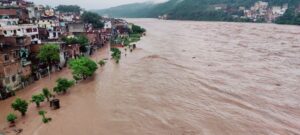Northern India Reel Under Rain Fury: 30 Pilgrims Killed at Vaishno Devi, Punjab Villages Inundated
Northern India is reeling under the fury of nature as torrential rains, cloudbursts and landslides have triggered death and devastation in Jammu & Kashmir and Punjab. At least 30 pilgrims were killed on the Mata Vaishno Devi shrine route in Reasi district, while hundreds of villages in Punjab are under water after the release of excess water from the Bhakra and Pong dams.

The most tragic incident unfolded on Tuesday on the sacred path to the Mata Vaishno Devi shrine. A massive landslide struck near Adhkwari in Reasi district, burying pilgrims under tons of debris. According to officials, 30 devotees lost their lives and 14 others sustained serious injuries. The annual pilgrimage, which attracts lakhs of worshippers, has been suspended indefinitely. Rescue teams of the National Disaster Response Force (NDRF), State Disaster Response Force (SDRF) and the Army rushed to the spot to evacuate stranded pilgrims and provide emergency aid to the injured.
The disaster coincided with an unprecedented cloudburst-like downpour in Jammu, which recorded 380 mm of rainfall in just 24 hours – the highest since records began in 1910. This figure surpassed the previous record of 270.4 mm registered in September 1988 and nearly touched Jammu’s monthly average of 403.1 mm for August. The relentless rain caused rivers including the Chenab, Tawi, Ravi, Basantar, Ujh and others to swell dangerously, flooding large tracts in Jammu, Kathua, Udhampur and Samba districts.
The scale of the calamity was evident as more than 5,000 people were evacuated from submerged low-lying areas. In Jammu city, the 4th bridge over the Tawi River collapsed under the onslaught of floodwaters. Train services between Jammu and Pathankot had to be suspended for nearly 24 hours before being restored late Wednesday. Road connectivity too remained in tatters with the vital Srinagar-Jammu National Highway, Srinagar-Leh road, Sinthan Pass leading to Kishtwar and Razdan Pass connecting Gurez all closed due to landslides and inundation.
In Kishtwar’s remote Warwan Valley, two separate cloudbursts on Tuesday evening washed away at least 10 houses, 300 kanals of standing crops, livestock and a bridge, leaving villagers devastated. Officials said the exact assessment of damage will be possible only after teams reach the cut-off valley.
Authorities ordered the closure of schools, colleges, training institutes and government offices in Jammu, while in Kashmir, educational institutions in Srinagar, Pulwama, Shopian, Kulgam and Anantnag were shut as a precautionary measure. Communication lines were severely hit, though partial mobile and internet services were restored by Wednesday afternoon by operators Jio and Airtel. BSNL advised its subscribers to switch to 2G to access limited connectivity.
Union Home Minister Amit Shah, J&K Lt. Governor Manoj Sinha and former Chief Minister Omar Abdullah expressed shock and grief at the tragedy. “Spoke to Hon PM @narendramodi Sb a short while ago. I briefed him about the situation in J&K from the worst hit areas as I toured the banks of the Tawi that saw huge damage. I am grateful for his assurance of continued assistance to the people of J&K,” Abdullah wrote on X. Sinha directed officials to prioritize restoration of power, water supply and communication in areas where floodwaters had begun to recede.
As J&K battled landslides and overflowing rivers, neighbouring Punjab too came under siege from the swollen Satluj, Beas and Ravi rivers. With heavy inflows from rain-battered Himachal Pradesh raising reservoir levels alarmingly, authorities were forced to open the floodgates of the Bhakra and Pong dams. The move prevented a potential dam safety risk but unleashed fresh flooding across Punjab’s heartland.
Hundreds of villages in Pathankot, Gurdaspur, Amritsar, Hoshiarpur, Fazilka and Jalandhar districts have been inundated, forcing large-scale evacuations. Rescue operations are being carried out by the Army, IAF, NDRF and local administration. Flooded homes, damaged roads and submerged fields presented a grim sight across Punjab’s countryside. Standing crops, particularly paddy, maize and vegetables, have been extensively damaged – the second such blow within a month.
Authorities said the inflow into reservoirs declined on Wednesday compared to Tuesday with reduced rainfall activity, offering some respite. Yet, the opening of floodgates has left Ropar, Anandpur Sahib and Hoshiarpur in Punjab, and Kangra in Himachal Pradesh, grappling with floodwaters.
With weather officials forecasting generally cloudy skies and intermittent showers over the next 24 hours, the threat of flash floods remains over hilly belts. People have been advised to stay away from rivers, streams and nallahs.
As the twin states of J&K and Punjab struggle to emerge from this natural calamity, the focus remains firmly on relief and restoration. Thousands are in relief camps, communication and power infrastructure lies battered, and agriculture – the backbone of the region – has taken a severe hit. The scale of destruction is still being assessed, but one thing is clear: the rain fury of August 2025 has etched itself as one of the most devastating weather disasters in recent memory for north India.
|Also Read :Ladakh Remains Cut Off for Third Day Due to Heavy Rains, Road and Air Links Hit :
Also Read : 6,000 evacuated as major rivers flow above alert level in J&K; Mata Vaishno Devi landslip toll rises to 34





